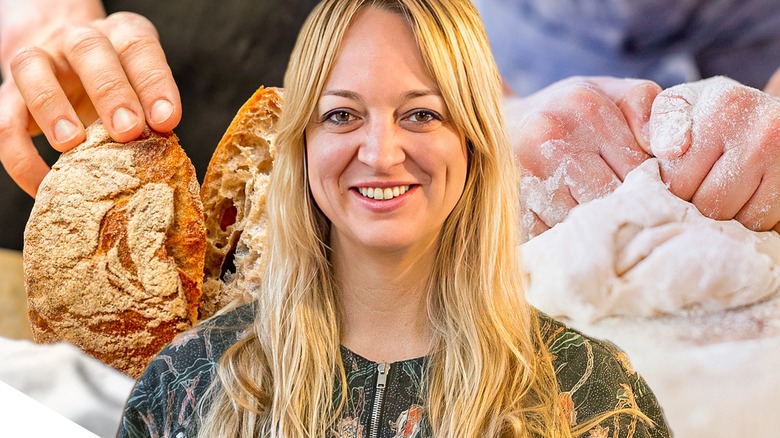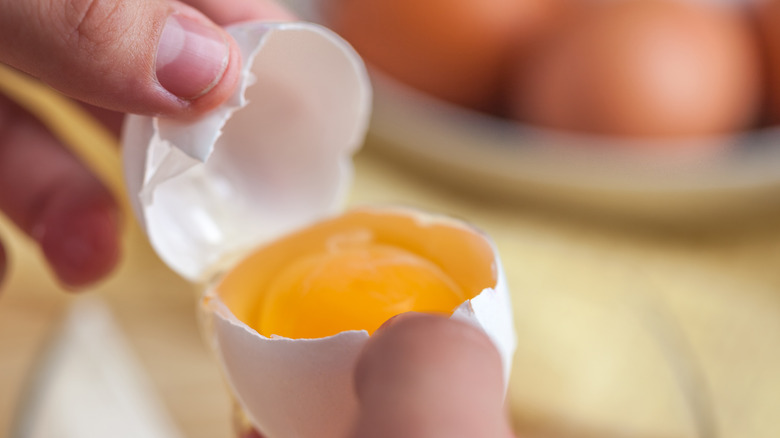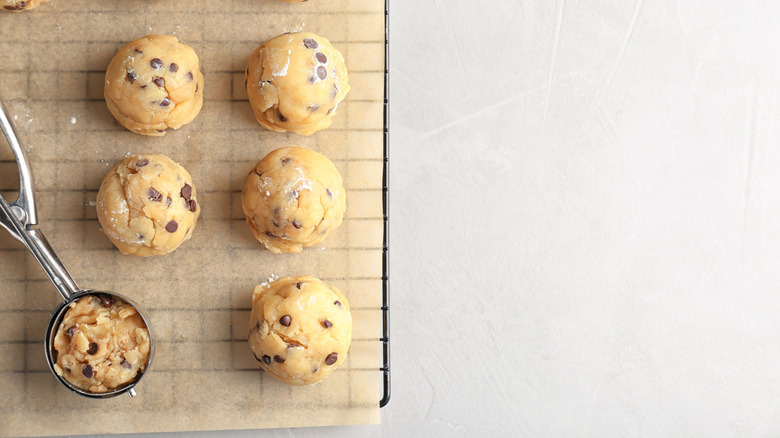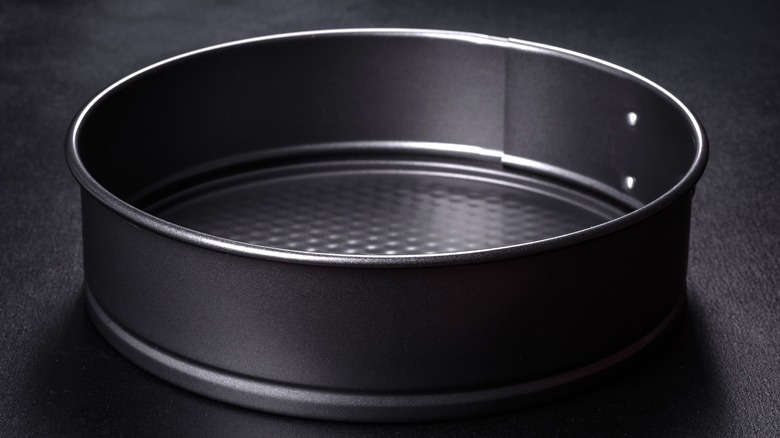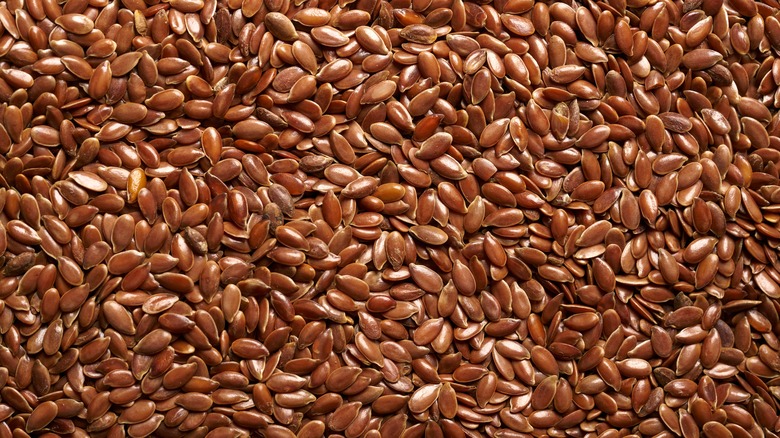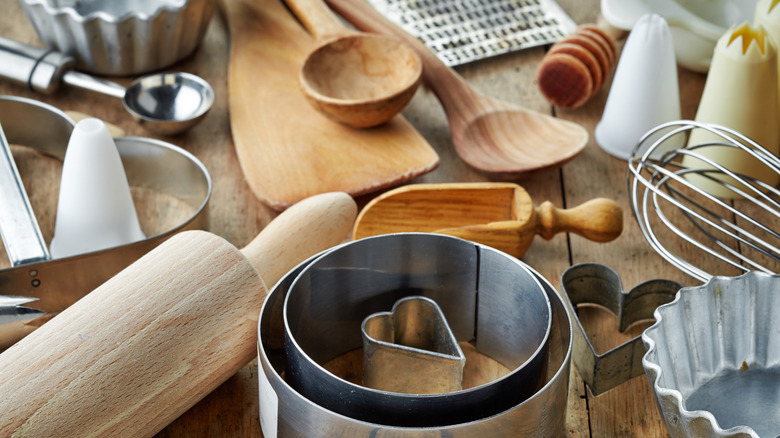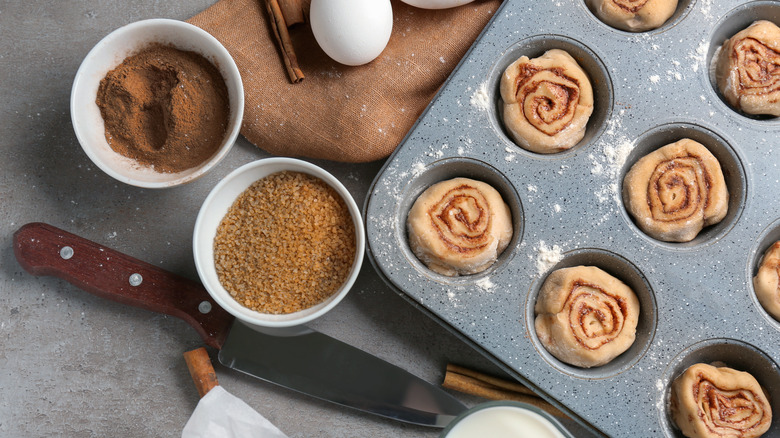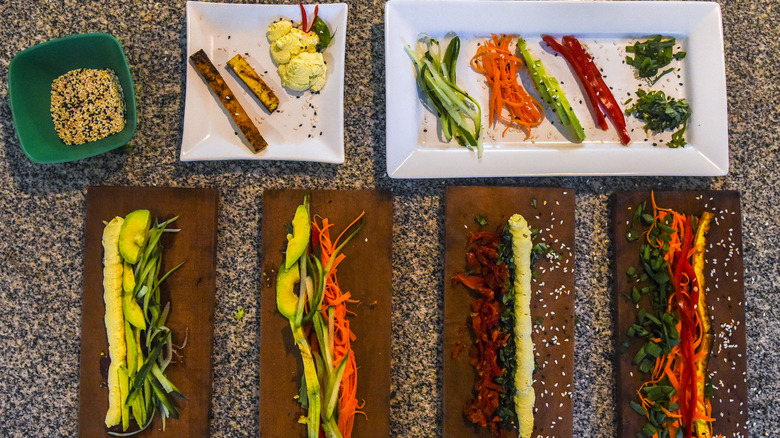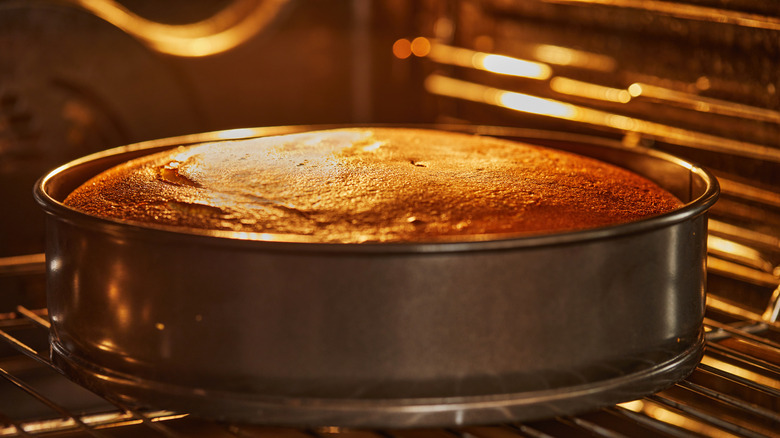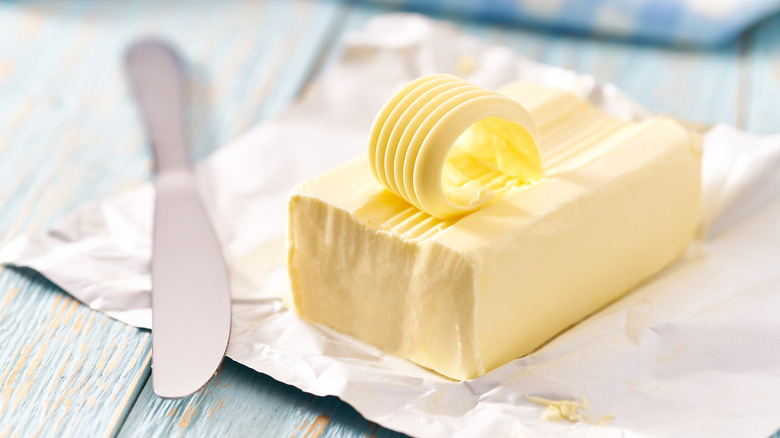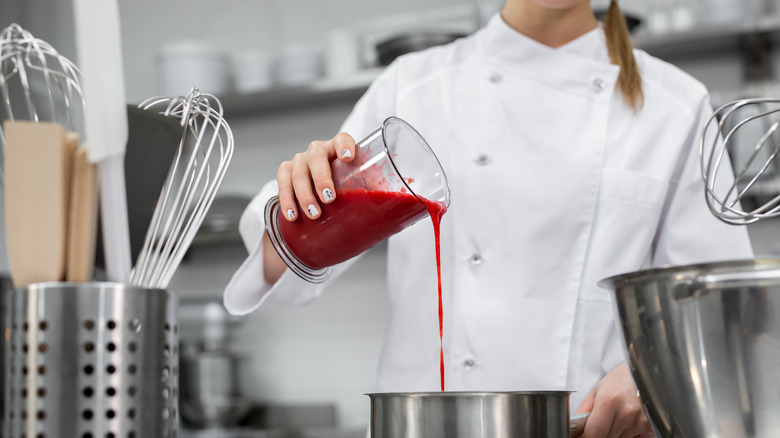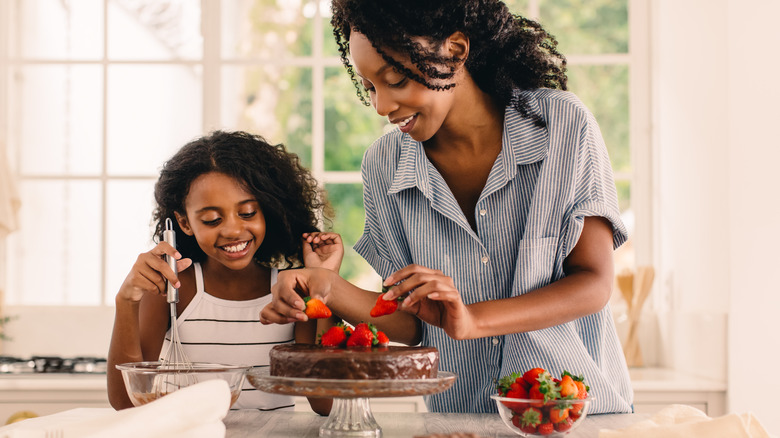Claire Ptak's 15 Best Baking Tips, Tricks, And Hacks - Exclusive
It's fair to say that Claire Ptak knows a few things about baking. Besides being an enthusiast for all things cake, Ptak is a food stylist, food writer, recipe developer, and owner of Violet Cakes in East London. She began her baking career as a pastry chef at Chez Panisse, where acclaimed chef Alice Waters mentored her. She then moved to London in 2005, where she started selling cakes on the Broadway Market before opening Violet Cakes in 2010. Ptak's baking style focuses on seasonality and quality ingredients, including some vegan and organic staples. In 2018, Ptak received high accolades for her elaborate lemon and elderflower wedding cake — which was one of the stars of the royal wedding of Prince Harry and Meghan Markle.
We had the opportunity to chat with Claire about all things cakes, cookies, and everything in between. Here are some of her best tips for home bakers.
Read the recipe a few times before starting
Being a great home baker is all about first being prepared. One of Ptak's first tips for bakers is to read the recipe at least two times before starting. "The most mistakes I find are made when you're kind of losing your place in the recipe, or you haven't read all the way through," she notes. "You get started, and you realize you don't have an ingredient or tool that you need, or you start mixing, and you've put, you know, like all the sugar in when you're only supposed to put half the sugar in."
When you're looking over a recipe for the first time, it's wise to assess when and where you'll have to add ingredients. Not only does this ensure you have all of the ingredients at the ready (because who has time to take a brief intermission and run to the grocery store, anyway?), but that you have a clear grasp of when and how your recipe is going to go.
Use egg yolks for a decadent chocolate chip cookie
One of the most popular treats at Violet Cakes is chocolate chip cookies, the recipe for which was published in both Ptak's book and The Guardian. Ptak's recipe uses three whole egg yolks, unlike other chocolate chip cookie recipes, which commonly use whole eggs.
Although she wouldn't suggest bakers swap out entire eggs for egg yolks in any cookie recipe due to the difference in proportions and precarious balance of ingredients, Ptak explains that her recipe for egg yolk chocolate chip cookies upgrades the flavor and texture of the cookies. She adds the egg yolks to her cookie recipe after creaming the butter and the sugar together with a bit of salt. "It makes for like this kind of crisp, crumbly exterior, and you can still get that like gooey kind of under-baked center," she mentions. "I feel like it just changed the chocolate chip cookie for me."
Scoop your cookie dough using an ice cream scoop
A large part of running a successful bakery is all about efficiency and presentation. One of the ways that Ptak and her staff efficiently scoop their cookie dough batter is with an ice cream scoop. Ptak notes not only does this save time (and the feeling of having sticky cookie dough all over your fingers), but it also "kind of looks like a bakery cookie" when you plop the cookie down on the sheet. In addition, she notes that this trick gives the perfectly round shape for cookies — which will also save you the agony of giving someone the smallest cookie in the batch.
You can purchase specially-designed cookie scoops of varying sizes, including 1, 2, and 3-tablespoon measurements, though the ice cream scoop will give you the biggest cookie. Since many of these scoops are designed with levers, you can quickly push out the same amount of batter for each scoop.
Don't wash your cake pans in the dishwasher
Everyone loves easy cleaning routines. But the one mistake you should avoid making in the kitchen is washing your cake pans in the dishwasher. Ptak notes that this is important because the dishwasher tends to ruin the finish on these pans, which in turn can mean that food is more apt to stick to the pan.
Even if your bakeware is non-stick and labeled as "dishwasher safe," you should still avoid putting it in the dishwasher. Instead, hand-wash your cookie sheets and non-stick bakeware with warm, soapy water and adequately dry it before storing. Aluminum pans are not coated with a non-stick finish and are easily susceptible to changing color if it is cleaned via a dishwasher. If you find flecks of cake or cookie residue stuck to your pans, gently scrub them with a nylon sponge and mild dish soap until the food residue has been removed. You should also try to clean these pans relatively quickly after use for better ease of cleaning.
Milled flax is a great vegan egg replacement
As Violet Cakes accommodates both vegan and non-vegan cake orders, Ptak prioritizes not only flavor in her vegan recipes but also textures. "I always want the texture to be as delightful and as delicious as possible," she notes. This includes looking beyond the animal-based ingredients in her recipes, such as choosing a flour that can break up the density of many vegan recipes.
Ptak's philosophy of using minimally processed ingredients is also very evident in her use of milled flax seeds as a replacement for eggs in her cake recipe — rather than more heavily-processed starch alternatives. "I like to keep things as whole as possible rather than using more processed ingredients... I think [milled flax seed] works really well, and I love the texture of that." Ptak also uses flax seeds for their numerous nutritional benefits, which include omega-3 fatty acids, fiber, and vitamins like thiamine.
Keep your baking tools lightweight
One of the kitchen tools that Claire Ptak can't live without is her anodized aluminum baking pans with a false bottom. "They bake really evenly and really well... and they're lightweight and easy to have in the kitchen," Ptak comments. She also recommends having a litany of other lightweight baking tools in the kitchen for easy use and moving from one place to another. Among these are large stainless steel mixing bowls, which can be easily cleaned and stacked on top of one another for storage.
There are some merits to having heavy baking tools, but Ptak notes that these are often more obstructive to carry and move around. She recounts having several ceramic mixing bowls when she first moved to London from California. She loves using these bowls for baking with family but notes that the stainless steel ones are much easier to use regularly.
Invest in a cake turntable for decorating
One of the tools that Claire Ptak recommends every home cook and amateur cake decorator has is a turntable. She notes that these are very helpful to have when decorating cakes because you can move the cake while frosting and decorating. While you can purchase inexpensive turntables, Ptak notes that the more expensive models typically have greater stability because they are heavy. "You can see the difference when you use one," she claims.
Another important cake-decorating tool Ptak swears by is an offset spatula. A quality offset spatula allows a cake decorator to apply an even coat of icing to a cake with better ergonomics than a standard spatula. This is because an offset spatula has a rounded, dull blade with a slight bend near the connection to the handle. Other uses for an offset spatula, besides making bakery-worthy cakes, include spreading hummus and peanut butter.
Level your cakes strategically
The perfect layer cake has an even and level finish. Of course, this wouldn't be possible without having a few tools handy to trim and cut the top of the cake so that every bit of the sponge lays evenly on the layer below. While many folks use a cake leveler, Ptak uses a long serrated knife to cut her layer cakes. She suggests that the size of the blade is important because it allows her to cut through the biggest cakes that the bakery makes.
One of Ptak's best hacks for home cooks is to leave the cake in the tin when you're trying to level it. If your cake is domed (the product of an uneven bake), Ptak notes that you can line up your knife with the rim of the cake pan and slice it evenly straight across. The other method she suggests is placing the cooled cake on the turntable because you can put the knife straight and rotate the cake around to trim it.
Bake your cinnamon rolls in a muffin tin
Baking can be a matter of getting creative and finding new ways to repurpose kitchen tools. One of Ptak's favorites is her muffin tin. Ptak uses this pan to make uniform cinnamon rolls, "It's nice because they come out so puffy and pretty." In her newest book, Ptak recommends using a muffin tin to make a blue cheese roll resembling a savory scone.
To utilize this hack, Ptak recommends rolling up the dough into a scroll and slicing 12 even pieces. Then, each roll can be easily transferred into a muffin tin. "If you didn't have a muffin tin, you could obviously bake them touching, flat on a parchment paper-lined baking tray," she notes. However, this method will produce a different roll shape for each. "I just feel like it's so nice when everything looks the same... when you're baking at home, you're always striving for uniformity and to make everything look more professional."
Establish a mise en place and keep it clean throughout
One of Ptak's fundamental tips for bakers is establishing a mise en place before mixing your ingredients. A mise en place is a French culinary term meaning that everything in its place. When baking, this might look like pulling all of your ingredients out of your refrigerator and cabinets and printing out your recipe. Hence, you have a hard copy to take notes on when you make the recipe next time.
Setting up your kitchen logically and concisely makes it easy to move from one step to another in the recipe. Ptak also recommends home cooks always keep their mise en place clear during cooking and clean as they go through the steps in their recipe. This will make the end of the baking process more manageable and allow you to keep an eye on whatever is in the oven.
Do what works best for your oven
Getting an even bake is something home cooks and baking professionals alike strive for. Ptak adopts a "low and slow" philosophy for most of her baking to promote an even bake. She notes that this helps the bakes develop a more even finish than a faster, hotter one. Ensuring an even bake is also about managing your oven space and cooking time — which comes down to knowing how your oven runs.
She notes that all ovens are "so different" that the hot spots and bake times may vary on particular recipes. Unlike other bakers, Ptak doesn't worry too much about opening and closing the oven during baking. "In the bakery, we have a 10-rack oven... so not everything is baking at the same time. We try to bake in batches where stuff is baking for roughly around the same amount of time, but it doesn't always happen." Instead, she recommends monitoring your bake closely to ensure that you can rotate and shift your placement around as needed.
Prepare your ingredients ahead of time
Preparation is the hallmark of a good bake, and Ptak has many tips for helping get everything ready in time for you to start cooking. "If I know I'm going to be baking with butter, I always take it out the night before and leave it outside of the fridge at room temperature... Of course, you can always microwave, but you tend to melt the butter, but it can be a mess and a disaster if it's too hot." Although butter is considered perishable, you shouldn't have to worry about leaving it out at room temperature for this extended period. Butter can be left out safely for one to two days before it is considered unsafe for consumption.
Like other bakers, Ptak warms up her eggs by rolling them around in a bowl of warm water for a few minutes before cooking. This ensures that the eggs blend much better with the rest of the batter, resulting in a smoother finished bake.
Explore the color and flavors of fruit purées
Much of Ptak's work at Violet Cakes centers around using fruit purées and whole ingredients in baking. "At the bakery, all of our icings are made with puréed fruits, so the color comes from the fruit, as well as the flavor." Ptak encourages bakers to experiment with these flavors to promote a newfound vibrancy in frostings, sponges, and other baked goods. "I'm just interested in what you can get from seasonal fruits and purées. I think people so are surprised when we don't use food coloring because we have such vibrant colors."
You'll need to be careful when adding fresh fruit to your buttercream frosting because it tends to make it too watery and runny. Instead, you can add freeze-dried fruit to your frosting, or boil the fruit down into a thick purée, cool it, and then mix it into your batter.
Be careful to avoid over-mixing
One of Ptak's best pieces of technical advice for baking is always to use a "light touch." She explains that bakers often tend to over-mix or over-whip batter because they desire a smooth consistency before putting their cake in the oven. However, as Ptak elucidates, this can lead to numerous issues with the texture and consistency of the bake. For example, an overbeaten cake tends to come out tough and full of air tunnels.
Ptak's advice for working with cake batter is to deliberately under-beat the sponge. This can slow down the gluten formation in the batter, which is one of the primary culprits for air tunnels. The gluten provides a strong web of protein strands, preventing air bubbles from escaping from the batter as the cake bakes. As a result, the air bubbles are forced out through the crumb and form undesirable channels in the cake. There are some ways that bakers can remediate this, though. Since gluten starts to form when liquid is manipulated with the flour, it is essential to work quickly and stir just so all of the dry flour is dispersed in the batter.
Get creative and trust your baking instincts
Claire Ptak has learned a lot through her many years of baking and remarks that it always comes with challenges. "My last little bit of advice is not to be afraid of your baking," she comments. "You'll have to make mistakes, and you'll have to try." Above all, she highlights the importance of preparation in crafting truly special and remarkable bakes. "Reading the recipe, getting your mise en place altogether... it's half the battle won already."
Although baking is a relatively precise science, Ptak also shares the importance of trusting your instincts. "If a recipe says to cook it for 45 minutes, and you're checking it at 20, and it looks almost done... you know, I would really learn to trust my instincts," she illustrates. By honing your baking skills with practice, creativity, and preparation in mind, you, too, can bake like Claire Ptak.
